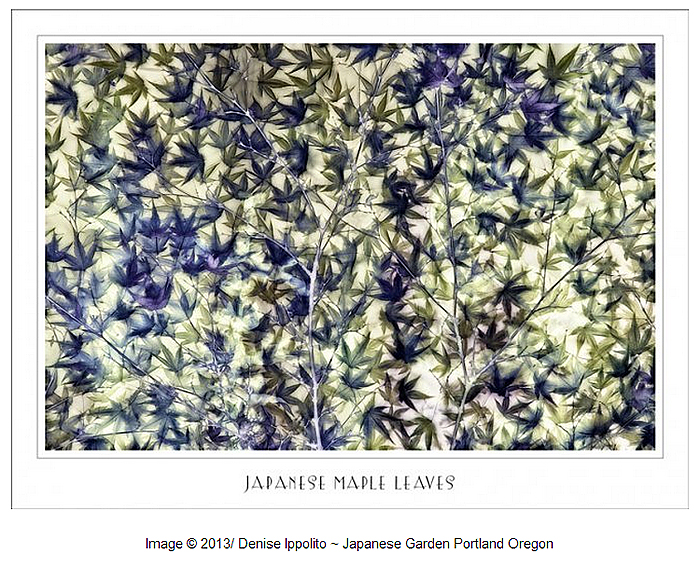
|
The MiniMag
The November issue of Denise Ippolito’s Creative MiniMag has been online for a few days now. In case you need some inspiration or just want to become a better photographer, be sure to click here. Denise opens the magazine by sharing a collection of participants’ images; each was created as a result of the graffiti photo assignment given to the workshop group on her recent trip to Toronto, Canada.
Tom Jeary’s incredible “The Chipmunk Fall Fair” has to be read and seen to be believed. In “Food Photography 101” Barbara Sammons shares her top five tips for photographing your favorite fare. Next Denise shares the Photoshop techniques and workflow that she used to fashion the lovely “Japanese Maple Leaves” creation above.
Everyone needs to read friend Scott Vincent’s moving “Making Pictures–The Voice.” With a series of powerful images Scott covers lots of ground including photographing controversial subject matter, the modern day whale slaughter that continues in Barrow, AK, and knowing right from wrong.
Mary Stamper’s article dealing with including shadows in our images. Yours truly details the creation of In-Camera HDR images with the Canon 5D Mark III; this article includes all of my favorite settings. In Denise’s “The Bear Neccessities” the publisher shares images and experiences from her first Katmai, AK Bear Boat trip this past September. Andrew McLachlan shares three of his favorite fall color multiple exposures and the set-up and techniques that he used to create them in-camera with his Nikon D800 .
Lisa Cuchara offers some great advice when she reminds us to ask, “Why Are Your Here?” when attending on-location photography workshops. The creative Anita Bower shares her thoughts on using the Nikon AF-S Nikkor 50mm f/1.8G lens to photograph flowers. In “Themes/Assignments Cheryl Slechta writes of getting out of the photographic ruts that we so often find ourselves in. Friend Nancy Bell shares the experience of photographing for a week in Cape Town, South Africa.
The MiniMag is both free and incredibly inspiring. It is always worth a click; if you visit, you will surely wind up subscribing.
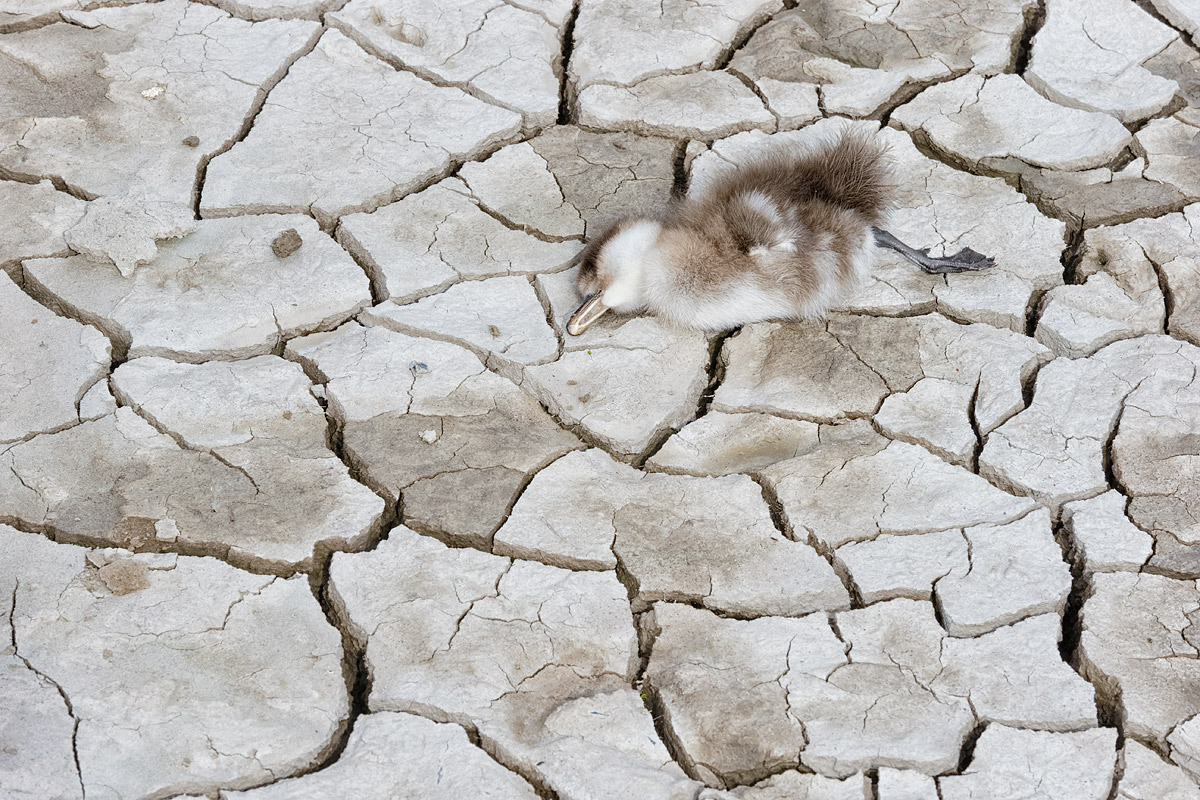
|
|
This dead Crested Duck image was created with the Gitzo 3532 LS carbon fiber tripod, the Mongoose M3.6 head, the Canon EF 70-200mm f/2.8L IS II USM lens at 182mm, and the Canon EOS-1D X. ISO 800. Evaluative metering +1 1/3 stops: 1/160 sec. at f/22 in Av mode. Central sensor/AI Servo Rear Focus AF on the duckling’s face and re-compose. Click on the image to see a larger version. |
Survival or Not… Death and Life on a Mudflat
While working shorebirds and Chilean Flamingos along the shore of a small lake at Morro Chico Steppe, Chile, I came across the fresh-dead Crested Duck duckling that you see in the image above. I picked it up, stuck it in the fanny pouch of my sweatshirt, and shared it with the group when we re-assembled. Then I posed it on the cracked mud, borrowed a 70-200, and began creating images.
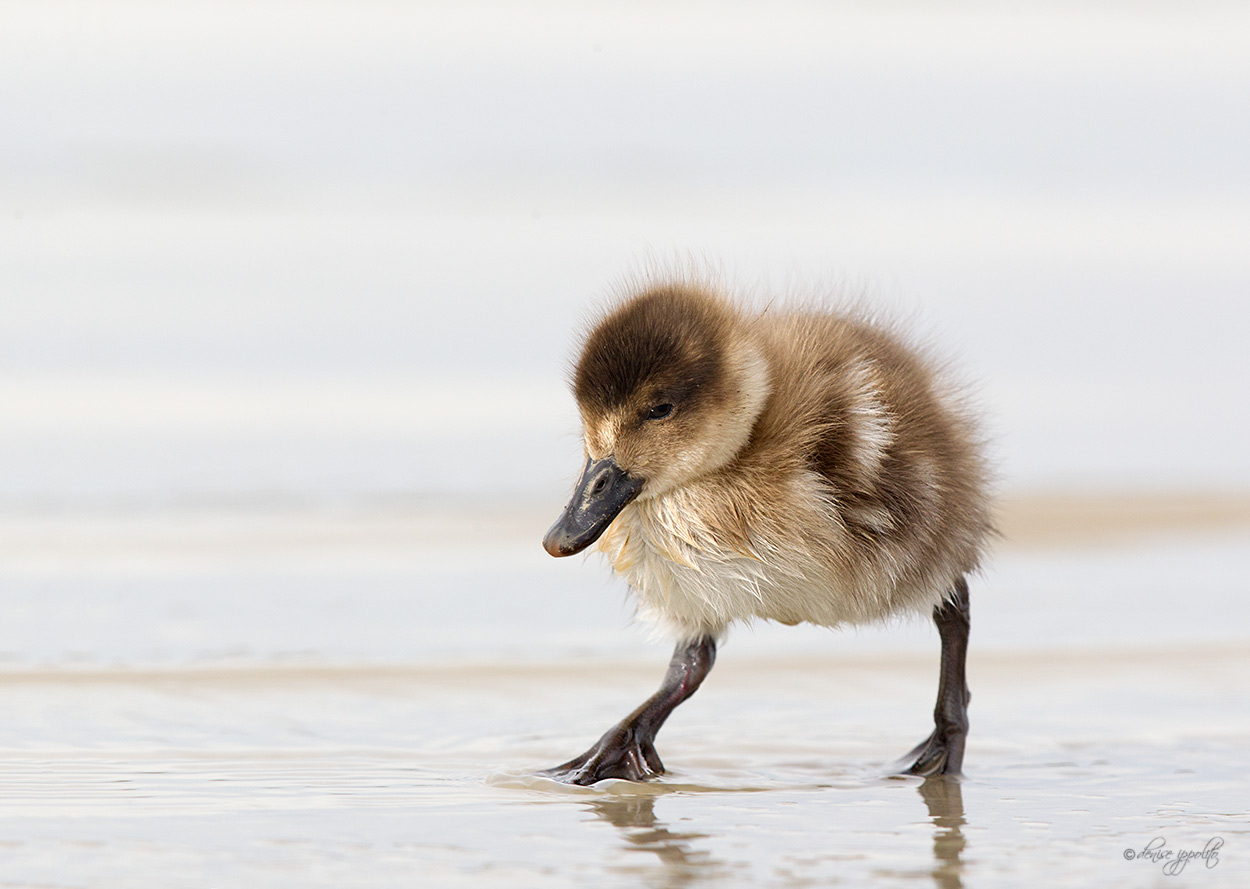
|
|
This Crested Duck duckling image was created with the Gitzo 3532 LS carbon fiber tripod, the Mongoose M3.6 head with the Integrated Low Mount Arm that Denise loves, the Canon EF 600mm f/4L IS II USM lens, the Canon 1.4x EF Extender III (Teleconverter), and the EOS 1D Mark IV (now replaced by the Canon EOS-1D X. ISO 800. Evaluative metering +1 stop: 1/1000 sec. at f/8 in Manual mode. Shutter button AF. Central sensor/AI Servo Shutter button Focus AF on the duckling’s face and re-compose. Click on the image to see a larger version. Image courtesy of and copyright 2013 Denise Ippolito/A Creative Adventure. |
The Surviving Siblings
I had gone to the far end of the pond trying without success to get close to winter-plumage White-rumped Sandpiper and Double-banded Plover. Denise Ippolito, who stayed behind, did very well on the white-rumpeds. When I headed back to the eastern end of the pond and found the dead duckling, Denise headed west and after a while, returned with a big smile on her face. One of the two surviving Crested Duck young had come up on the shore to forage and allowed close approach. The other was swimming in the middle of the lake with momma who was calling constantly as she was not very happy with the adventurous chick.
Image Questions
Which of the two images above is your favorite? Please let us know why. Why f/22 for the first image? If you kept the same framing, why might the 100 macro have been a better lens choice for the first image?
EOS-1D X Autofocus Guide
Until I get around to doing a complete user’s guide for the 1D X my 1D X Autofocus Guide will help you to master and get the most out of my all time favorite professional digital camera body. It includes my customized Case setting for photographing birds in flight and in action.
5D Mark III User’s Guide
EOS-5D Mark III User’s can learn to set up and use their cameras exactly as I do. Includes detailed advice on all menu and custom function items, AF suggestions, and all you need to know about creating great in-camera HDRs and Multiple Exposures.
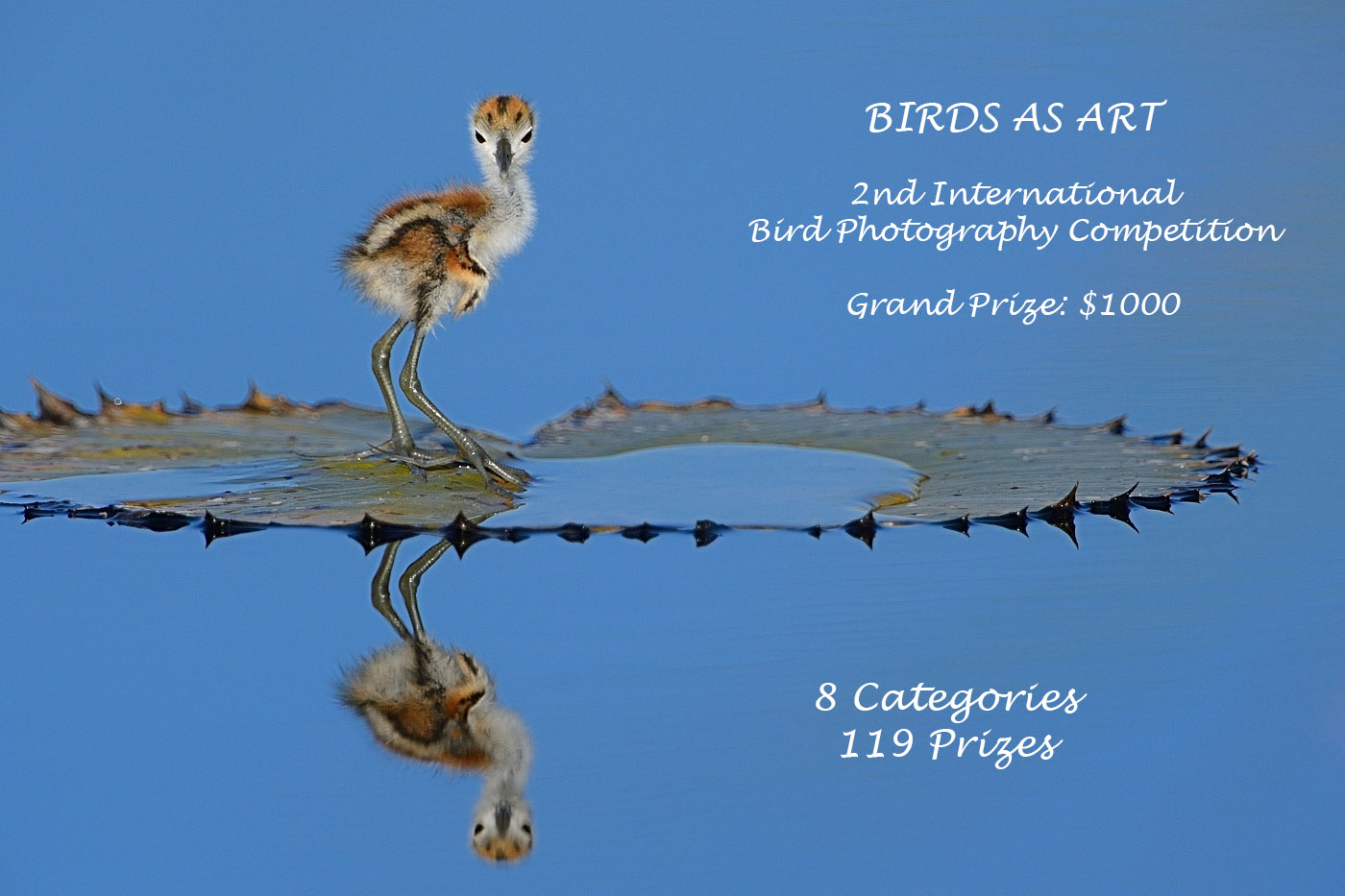
|
BIRDS AS ART 2nd International Bird Photography Competition
Learn more and enter the BIRDS AS ART 2nd International Bird Photography Competition here. Twenty-five great prizes including the $1000 Grand Prize and intense competition. Bring your best.
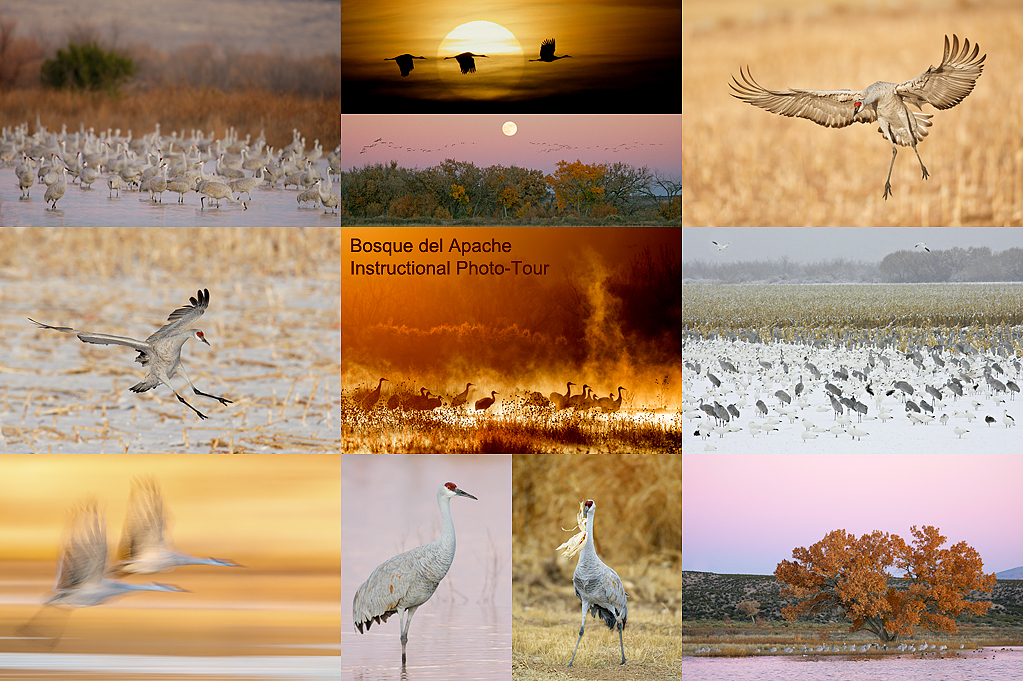
|
|
Bosque Sandhill Crane Composite; click on the image to enjoy a larger version. |
Bosque del Apache 2013 IPT: “The Complete Bosque Experience.” NOV 26-DEC 2, 2013. 7-FULL DAYS: $3399. Co-leader: Denise Ippolito. Introductory Slide program: 6:30 pm on 11/25. Limit: 12/Openings 8.
Please see the info on the short version of this IPT below if you will be spending Thanksgiving with your family.
Tens of thousand of Snow Geese, 10,000 Sandhill Cranes, ducks including point-blank American Wigeon and Wood Duck, amazing sunrises, sunsets, and blast-offs. Live, eat, and breathe photography with one of (if not the) world’s premier photographic educators at one of his very favorite locations on the planet. Top-notch Photoshop instruction. This will make 19 consecutive Novembers at Bosque for me. Nobody knows the place better than I do. Join us to learn to think like a pro, to recognize situations and to anticipate them based on the weather, especially the sky conditions, the light, and the wind direction. Every time we make a move we will let you know why. When you head home applying what you learned will prove to be invaluable. Includes all lunches and the Thanksgiving Buffet at the Crowne Plaza in Albuquerque. I hope that you can join me for what will be an unparalleled learning experience.
There is never a strict itinerary on a Bosque IPT as each day is tailored to the local conditions at the time and the weather. We are totally flexible in order to maximize both the photographic and learning opportunities. There is an introductory slide program on the night before the tour begins. We are up early each day leaving the hotel by 5:30 am to be in position for sunrise. After 18 years we pretty much know where to be when in what sky conditions and what winds. We usually photograph until about 10:30am. Then it is back to Socorro for lunch and then a classroom session with the group most days. We head back to the refuge at about 3:30pm each day and photograph until sunset. Then dinner with the group most nights. We always spend at least one afternoon at the ponds at the Albuquerque Zoo doing Wood Ducks and usually two mornings at New Mexico Tech doing American Wigeons. The rest is Snow Geese and Sandhill Cranes with the emphasis on expanding both your technical skills and your creativity.
A $500 non-refundable deposit is required to hold your slot for this IPT. Your balance, payable only by check, is due now. You will receive an e-mail notifying you of that after you place your deposit. If the trip fills, we will be glad to apply a credit applicable to a future IPT for the full amount less a $100 processing fee. If we do not receive your check for the balance on or before the due date we will try to fill your spot from the waiting list. If your spot is filled, you will lose your deposit. If not, you can secure your spot by paying your balance.
Please print, complete, and sign the form that is linked to here and shoot it to us along with your deposit check (made out to “Arthur Morris.”) You can also leave your deposit with a credit card by calling the office at 863-692-0906. If you register by phone, please print, complete and sign the form as noted above and either mail it to us or e-mail the scan. If you have any questions, please feel free to contact me via e-mail.
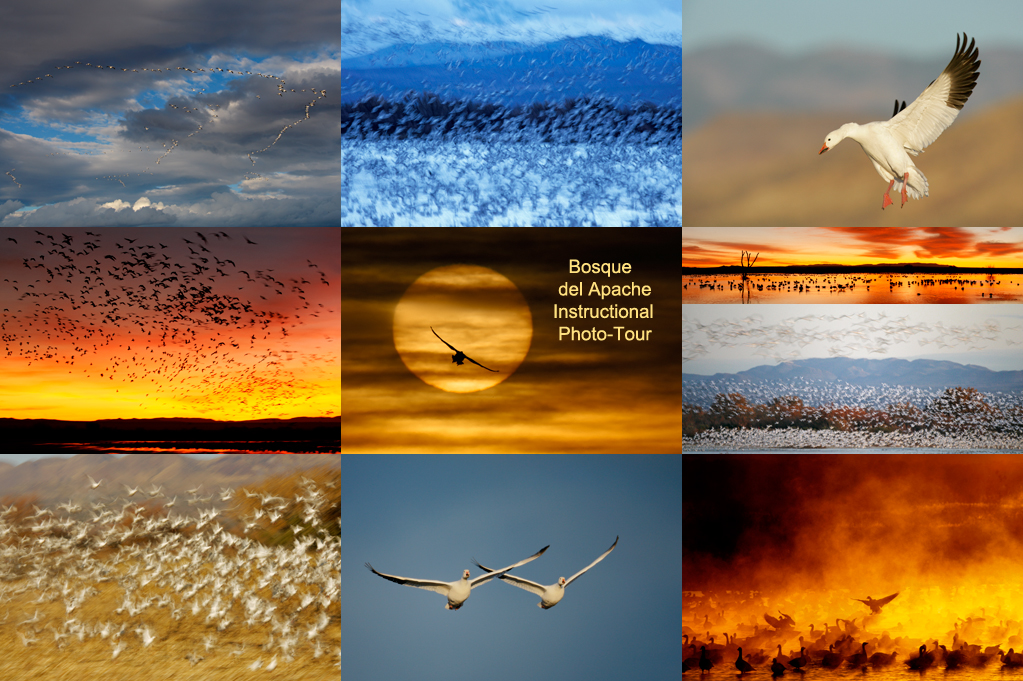
|
|
Bosque Snow Goose Composite; click on the image to enjoy a larger version. |
Bosque del Apache 2013 IPT: “The Short Version.” NOV 30-DEC 2, 2013. 3-FULL DAYS: $1199. Co-leader: Denise Ippolito. Introductory Slide program: 7:30 pm on 11/29. Limit: 12/Openings 4.
Tens of thousand of Snow Geese, 10,000 Sandhill Cranes, amazing sunrises, sunsets, and blast-offs. Top-notch Photoshop instruction. This will make 19 consecutive Novembers at Bosque for artie. Nobody knows the place better than he does. Join us to learn to think like a pro, to recognize situations and to anticipate them based on the weather, especially the sky conditions, the light, and the wind direction. Every time we make a move we will let you know why. When you head home applying what you learned will prove to be invaluable. Includes all lunches. I hope that you can join us for these three great days; they will offer a great learning experience.
There is never a strict itinerary on a Bosque IPT as each day is tailored to the local conditions at the time and the weather. We are totally flexible in order to maximize both the photographic and learning opportunities. There is an introductory slide program on the night before the tour begins. We are up early each day leaving the hotel by 5:30 am to be in position for sunrise. After 18 years we pretty much know where to be when in what sky conditions and what winds. We usually photograph until about 10:30am. Then it is back to Socorro for lunch and then an informal Photoshop/image review session with the group most days. We head back to the refuge at about 3:30pm each day and photograph until sunset. We may spend an afternoon at the ponds at the Albuquerque Zoo doing Wood Ducks and we may spend a late morning at New Mexico Tech doing American Wigeons. The rest is Snow Geese and Sandhill Cranes with the emphasis on expanding both your technical skills and your creativity.
A $500 non-refundable deposit is required to hold your slot for this IPT. Your balance, payable only by check, is due now. You will receive an e-mail notifying you of that after you place your deposit. If the trip fills, we will be glad to apply a credit applicable to a future IPT for the full amount less a $100 processing fee. If we do not receive your check for the balance on or before the due date we will try to fill your spot from the waiting list. If your spot is filled, you will lose your deposit. If not, you can secure your spot by paying your balance.
Please print, complete, and sign the form that is linked to here and shoot it to us along with your deposit check (made out to “Arthur Morris.”) You can also leave your deposit with a credit card by calling the office at 863-692-0906. If you register by phone, please print, complete and sign the form as noted above and either mail it to us or e-mail the scan. If you have any questions, please feel free to contact me via e-mail.
2014 Tanzania Summer Safari
If you are interested in joining us in Tanzania next summer please shoot me an e-mail and I will be glad to forward you the PDF with dates, itinerary, and price.
Support the BAA Blog. Support the BAA Bulletins: Shop B&H here!
We want and need to keep providing you with the latest free information, photography and Photoshop lessons, and all manner of related information. Show your appreciation by making your purchases immediately after clicking on any of our B&H or Amazon Affiliate links in this blog post. Remember, B&H ain’t just photography!




Amazon
Everyone buys something from Amazon, be it a big lens or deodorant. Support the blog by starting your search by starting your search by clicking on the logo-link below. No purchase is too small to be appreciated; they all add up. Why make it a habit? Because I make it a habit of bringing you new images and information on an almost daily basis.
Typos
In all Bulletins, feel free to e-mail or leave a comment regarding any typos, wrong words, misspellings, omissions, or grammatical errors. Just be right. 🙂
IPT Info
Many of our great trips are filling up. Two great leaders ensure that you will not learn more anywhere about how to make great images. Click here for the schedule and additional info.














Well said David. See Scott’s reply to my question on his Minimag article.
Wow, tough choice. And why do I need to make it…? Both are wonderful photos that would be an asset to any portfolio.
🙂
I guess I’ll chicken out and say both are my favorites. Each one tugs at me…one shows death and the other the beginning of life.
In regards to F22…you were probably fairly close so to get everything in sharp focus, including the cracks, you needed to stop down as much as you could since DOF decreases as you get closer to the subject.
Macro…To achieve a more life like (or maybe even slightly larger than) subject size to emphasize not only the ducking but the cracks?
Doug
Hi, Artie. What a post…First, your two images. I prefer the second, mainly for emotional reasons; the first one is sad. It’s reality, which I as a biologist fully understand, but that doesn’t mean I prefer to look at it over the live, active chick. Both are superb technically and compositionally. I expect you used f/22 in the first image to get the whole image as sharp as possible. I’m not sure why a 100 mm macro would have been better than the brilliant 70-200 f/2.8L II. Second, Denise’s wonderful minimag and whales in Barrow. I too have photographed Alaska Natives bringing in and butchering a bowhead whale at Barrow. It was September of 1992 and obviously I was using film, but other than that, if you put my photos alongside Scott Vincent’s, you wouldn’t notice any time-related difference. The children played on the whale, there were celebrations, and the tractor pulling the whale up the beach looks as if it could be the same machine. The issues surrounding cultural differences are immensely complex. I have spent many days over many decades among Alaska Natives, and what modern western culture has done to them is tragic. Some have adapted well, others less so. Clearly, whaling is deeply rooted in their culture. As for the “slaughter,” which includes the connotation of indiscriminate or excessive killing, in that sense what the Barrow Natives do is not a slaughter. The whale population is carefully monitored and managed and has been increasing. Roughly 30, plus or minus 10, whales are taken by the Natives each year, and the total bowhead whale population probably is more than 10,000 and the population overall is not threatened by the hunting. Now these facts say nothing about the moral, ethical, spiritual, religious, and other personal issues associated with the Natives’ killing and use of whales, which are complicated and difficult. I do not offer my own opinion here on whether they should be allowed to take whales, but if this post helps even one person look at the issue with a broader perspective than they had before, then I’ll be pleased.